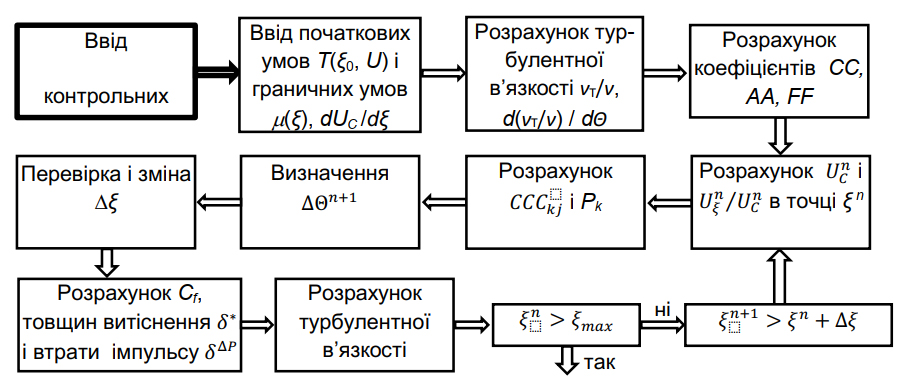SIMULATION OF BOUNDARY LAYER UNDER LAMINAR AND TURBULENT MODES OF NEWTONIAN FLUID MOTION IN A FLEXIBLE PIPELINE
Abstract
The article deals with the modeling of boundary layer parameters for Newtonian fluids under laminar and turbulent modes of motion. Based on the system of Prandtl equations and initial boundary conditions under laminar motion, using the Gallorkin method, a tri-diagonal system of equations is formed, which connects the values of functions at the node of nets n+1 across the boundary layer. The numerical method uses the Thomas algorithm to calculate values Ujn+. The velocity value Vjn+1 is determined from the continuity equation by integration across the boundary layer. The Navier-Stokes equation in dimensionless form was used to model the turbulent boundary layer, given the velocity U is an independent variable. The differential equation system was solved using the numerical Dorodnicin method. The results of modeling the velocity distribution in the boundary layer, the thickness of the boundary layer in the section of the flexible pipeline 0.8-1.5 m from the beginning of the fluid entering the pipeline at the expense up to 0.1 kg/s are presented.
References
He, S. & Ariyaratne, C. (2011). Wall shear stress in the early stage of unsteady turbulent pipe flow. Journal of Hydraulic Engineering, 137(5), 606–610.
Sundstrom, L.R.J. & Cervantes, M.J. (2018). On the Similarity of Pulsating and Accelerating Turbulent Pipe Flows. Flow, Turbulence and Combustion, 100 (2), 417- 436. https://doi.org/10.1007/s10494-017-9855-5
Kong, R. & Kim, S. (2015, August - September). Characterization of Horizontal Airwater Two-Phase Flow. The 16th International Topical Meeting on Nuclear Reactor Thermal Hydraulics (NURETH-16). (pp. 5559-5572). Chicago / USA.
Offor, U. H. & Alabi, S. B. (2016). An Accurate and Computationally Efficient Explicit Friction Factor Model. Advances in Chemical Engineering and Science, 6, 237-245. http://dx.doi.org/10.4236/aces.2016.63024 (in
Medina, Y. C., Fonticiella, O. M. C. & Morales O. F. G. (2017). Design and modelation of piping systems by means of use friction factor in the transition turbulent zone. Mathematical Modelling of Engineering Problems, 4 (4), 162-167. DOI: 10.18280/mmep.040404
Azizi, N., Homayoon, R., & Hojjati, M. R. (2018). Predicting the Colebrook-White friction factor in the pipe flow by new explicit correlations. Journal of Fluids Engineering, 141 (5), doi:10.1115/1.4041232
Pimenta, B. D., Robaina, A. D., Peiter, M. X., Mezzomo, W., Kirchner, J. H. & Ben, L. H. B. (2018). Performance of explicit approximations of the coefficient of head loss for pressurized conduits. Brazilian Journal of Agricultural and Environmental Engineering (Revista Brasileira de Engenharia Agrícola et Ambiental), 22 (5), 301-307. Retrieved from http://www.agriambi.com.br
Tarek, A. Ganat, & Meftah Hrairi. (2018). Gas–Liquid Two-Phase Upward Flow through a Vertical Pipe. Influence of Pressure Drop on the Measurement of Fluid Flow Rate, Energies (MDPI), 11 (11), 1-23. doi:10.3390/en11112937
Brkic, D. & Praks, P. (2018). Unified Friction Formulation from Laminar to Fully Rough Turbulent Flow. Applied Sciences, 8(11), 20-36. doi: 10.3390/app8112036
Ortiz-Vidal, L. E., Mureithi, N. & Rodriguez, O. M. H. (2013, May). Friction Factor in TwoPhase Gas-Liquid Pipe Flow. 8-th International Conference on Multiphase Flow ( ICMF-2013) Jeju / Korea. Retrieved from
https://www.researchgate.net/publication/237079232
Lukman, S. & Oke, I. A. (2017). Accurate Solutions of Colebrook-White’s Friction Factor Formulae. Nigerian Journal of Technology (NIJOTECH), 36(4), 1039–1048. Nigeria.
Landau, L.D., & Lifshitz, E.M. (1988). Theoretical physics. Hydrodynamics. Moscow: Nauka.
Fletcher, C. A. J. (1988). Computational Techniques for Fluid Dynamics 1: Fundamental and General Techniques. Springer-Verlag, Heidelberg, Berlin.
Lojciansky, L.G. (1950). Fluid and gas mechanics. Moscow: Gosizdat of technical and theoretical literature.
Dorodnitsyn, A.A. (1960). On one method for solving the laminar boundary layerequations. Applied mechanics and technical physics, 3. 111-118.




